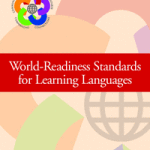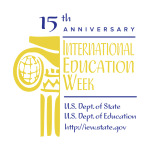 The American Council on the Teaching of Foreign Languages (ACTFL) in conjunction with its partner organizations of the Standards Collaborative Board, will introduce the newly-revised World-Readiness Standards for Learning Languages at its upcoming annual Convention and World Language Expo in San Antonio, Texas, this week.
The American Council on the Teaching of Foreign Languages (ACTFL) in conjunction with its partner organizations of the Standards Collaborative Board, will introduce the newly-revised World-Readiness Standards for Learning Languages at its upcoming annual Convention and World Language Expo in San Antonio, Texas, this week.
New U.S. ‘World-Readiness’ Standards
Celebrate International Education Week
 Today marks the beginning of the 15th annual International Education Week – an opportunity to celebrate international education and global exchange.
Today marks the beginning of the 15th annual International Education Week – an opportunity to celebrate international education and global exchange.
This joint initiative of the U.S. Department of State and the U.S. Department of Education is part of an effort to promote programs that prepare Americans for a global environment and attract future leaders from abroad to study, learn, and exchange experiences in the United States.
Our activities will be held from November 17-21, 2014. The dates for IEW 2015 are November 16-20, 2015.
The departments encourage the participation of all individuals and institutions interested in international education and exchange activities, including schools, colleges and universities, embassies, international organizations, businesses, associations, and community organizations. Individuals and institutions tend to hold IEW events as it is convenient for them in their local communities. We want you to celebrate as much and as often as you like! To that end, they are providing promotional materials that allow you the flexibility to promote events whenever they may be planned!
Fun Ideas for Family Literacy Month

November is Family Literacy Month, and the National Center for Families Learning is promoting their guide to 30 Days of Families Learning. The guide has literacy activities and practices for every day of the month designed to inspire family memory-making as families play, imagine and learn together. Activities include “Mystery Dinner Guests,” where each person chooses and researches a famous person before dinner, and then while eating everyone takes turns asking questions about each other’s mystery person, trying to guess the guest; or “Listen to Your Children’s Stories,” where children tell a story to the adults, and the adults write down the stories and save them to be read in the future. Many of the activities are excellent even for youngsters who aren’t quite reading yet, as they stimulate language and story-telling skills.
Reading Rockets also has free, printable reading adventure packs online for fostering literacy this month. Reading adventure packs include both fiction and nonfiction reading materials, a creativity activity, an imagination activity and a “get real” activity, which focuses on real-world experiences for parent and child. The packs are organized by grade level and theme, and can be downloaded from the Reading Rockets website.
For teachers, the International Reading Association has compiled literacy lesson plans for K-8 classrooms. The lesson plans all involve students’ families. Lessons include creating family timelines, sharing family stories, and writing to their families.
Elementary Practicals
Lisa Lucas discovers what we can learn from the UK’s mandating of world language education in all elementary schools from second grade
The British government, in recognition of the value of language learning in early childhood, took a bold step this year and mandated compulsory teaching of a second language for children ages seven to eleven in English primary [elementary] schools. As of this September, all primary school students are required to study one of seven languages, and though the most popular choice is French, followed by Spanish, some schools offer Mandarin and Arabic. Many believe that this move is essential for the UK to remain competitive with its European counterparts. This is clearly a commendable move, but is it an incredible advance or a wildly optimistic plan? How will the schools actually implement this, and is there support in place to see this plan comes to successful fruition?
To read the full story, click here.
Miguel Angel Asturias Spanish School
Miguel Angel Asturias Spanish School in Quetzaltenango, Guatemala, offers 25 hours of private one-on-one instruction, homestay with all meals, and activities for only $150 per week. Using the school’s interactive immersion method, a student will speak for hours a day and make vast progress in a short amount of time. In addition to learning the language, students also learn about the realities of life in Guatemala and Latin America, taking away a deeper understanding of this part of the world. Many of Miguel Angel Asturias Spanish School’s teachers have been there for ten years or longer. Each one has a unique perspective, based on a broad array of specialties and experiences, to lend to in-class discussions of a wide range of topics. A founding principle of the school is to give back to the community, and both directors have degrees in economics with a wide variety of experience working with rural communities. They offer students the opportunity to share their own skills, interests, and enthusiasm helping the people of Guatemala while practicing and improving the student’s Spanish.The Miguel Angel Asturias Spanish School’s highly regarded medical Spanish program combines intensive general Spanish instruction with specialized instruction focused on medical terminology and situations. It is ideal for doctors, nurses, medical school students, pre-med students, emergency medical technicians, and others in the health care fields. Students may also choose to volunteer in a rural hospital or clinic. Their veterinary medical Spanish program has a similar structure and volunteer options.
COINED
 The idea behind COINED is that the schools emulate Latin America — an amazingly varied region with glaciers on one side and Caribbean beaches on the other, not to mention tropical jungles, snowy peaks, deserts, and salt flats. COINED has been organizing international experiences for students from all over the world in Latin America for over 40 years. Today, students can follow their passions as they choose from Spanish schools, internship and volunteer programs in over 40 locations across 15 countries — from Argentina through Chile, Peru, Cuba, and Guatemala to Mexico. Students can select their destination, pick any Monday of the year to start the program, and plan their own study routes combining multiple locations and programs. Those interested in nature, education, or community work can choose worthwhile volunteer programs. University students, graduates, and those changing careers can invest their time in internship, in any professional field.
The idea behind COINED is that the schools emulate Latin America — an amazingly varied region with glaciers on one side and Caribbean beaches on the other, not to mention tropical jungles, snowy peaks, deserts, and salt flats. COINED has been organizing international experiences for students from all over the world in Latin America for over 40 years. Today, students can follow their passions as they choose from Spanish schools, internship and volunteer programs in over 40 locations across 15 countries — from Argentina through Chile, Peru, Cuba, and Guatemala to Mexico. Students can select their destination, pick any Monday of the year to start the program, and plan their own study routes combining multiple locations and programs. Those interested in nature, education, or community work can choose worthwhile volunteer programs. University students, graduates, and those changing careers can invest their time in internship, in any professional field.
Spanish at Locations
Spanish at Locations is an organization with schools located in attractive tourist areas of Costa Rica and Panama. The Costa Rican school in Turrailba is located in a charming little town in the lush and beautiful Central Valley in the Cartago province. Famous for being a white-water-rafting hotspot and base camp, this town lies 35 miles east of the capital city, San José, and is an excellent place to tour pre-Columbian ruins at Guayabo or the rarely visited but lovely Parque Nacional Volcán Turrialba. A quiet town, Turrialba, with its charming street corners and gorgeous surrounding sceneries, is among the few places in Costa Rica with direct access to the volcano’s crater. On a clear day, the Irazú, Poás, and Barva volcanoes are visible from the summit of the Turrialba Volcano. The school in Costa Rica — Spanish by the Sea — was founded in 2012 and is located in the town Puerto Viejo de Talamanca, a small, laidback beach town located on the Caribbean Coast close to the Panamanian border. Apart from its natural jungle beauty Puerto Viejo is known for its waves which attract surfers from all over the world due to their height and consistency. Spanish at Locations has three schools in Panama which is becoming a popular destination among students and expats alike.
Tandem Santiago
Tandem Santiago–Escuela de Idiomas Violeta Parra has been offering Spanish immersion courses since 1992, making it one of the oldest specialist schools in Chile. The school has been awarded the Excellence Award from LanguageCourses.net for the last eleven years, thanks to high levels of customer satisfaction. With about 40 students in group courses divided into nine levels, small groups are guaranteed. The school’s “fast–track” method suits many learners by accelerating the learning process, with convincing results in twelve weeks of intensive immersion. As a member of the Tandem International Network of quality schools it offers Tandem interchange activities with local students in mixed groups and language-learning pairs in which international students teach English to Chilean English students in return for Spanish lessons. Social activities, museum visits, and eco-tourism trips are also available.
AEC Spanish Camps
The AEC Spanish Institute in Costa Rica is all about studying Spanish and exploring the land. Meet the real Costa Rica with AEC as your language and adventure guide. They began their language program with more than 20 years of language and adventure experience. They have extensive experience accommodating high school and college groups from arrival to departure. With a teacher to student ratio of no more than six to one, the language experience is exemplary. Three dynamic locations — Turrialba, Playa Dominical and Arenal — offer students opportunities to experience three distinct regions. Playa Dominical is a small, friendly village with the most consistent waves in Costa Rica. Turrialba, located in the central highlands, offers a highly immersive language experience with few tourists. The Arenal campus located near the Arenal Volcano offers medical spanish and standard Spanish with private classes. AEC offers Spanish immersion, teen language and volunteer camps, Children’s Programs from preschool to age 13.
Universidad de la Sabana’s Vive Español
The university offers a program in Spanish to help international students learn the language and improve communicative competence by working in the four language skills — listening, writing, speaking, and reading — whilst giving participants the opportunity to get to know Colombia. Classes start every Monday and are delivered in the morning to give students the opportunity to participate in other activities in the afternoons. Students can choose the number of weeks they want to study and when to start. Vive Español unites language learning, the richness of Colombian culture, and many extracurricular activities to provide students with an incredible and authentic experience throughout their stay.



